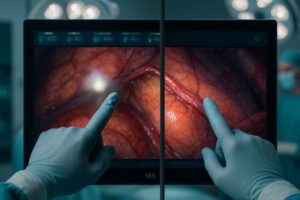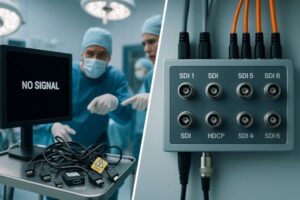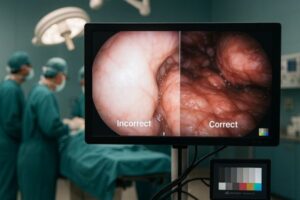Imagine a surgeon relying on a blurry monitor during a delicate procedure. Patient safety demands crystal-clear visuals. This is why surgical displays matter so much.
Surgical displays are specialized medical monitors designed for operating rooms, offering high resolution, accurate color reproduction, and ruggedized construction for sterile environments. They provide surgeons with the visual clarity needed to perform precise and safe procedures – differentiating them from standard consumer displays.

Why Are Surgical Displays Essential in the Operating Room?
I’ve seen surgeons struggle with consumer monitors during critical surgeries. The frustration on their faces was palpable, and the risks were real.
Surgical displays are essential because they provide surgeons with real-time, high-definition images of the surgical field, enhancing precision, reducing errors, and improving patient outcomes. Clear visualization is key to successful surgery.

In my experience, surgical displays are critical for:
-
Enhanced Visualization1: High resolution and contrast allow surgeons to see fine details that might be missed on a standard monitor. This is especially crucial in minimally invasive procedures.
-
Reduced Eye Strain2: Surgical procedures can last for hours. High-quality displays reduce eye strain, allowing surgeons to maintain focus and precision throughout the operation.
-
Improved Communication3: Surgical displays allow the entire surgical team to view the procedure simultaneously, fostering better communication and collaboration.
How Do Surgical Displays Differ from Regular Monitors? It’s Not Just Resolution!
I once made the mistake of suggesting a consumer monitor for a surgical suite upgrade. The OR staff laughed me out of the room.
Surgical displays differ from regular monitors in several key aspects: medical-grade certifications, superior image quality, ruggedized design, and specialized features like DICOM compliance. These features ensure reliability, accuracy, and safety in the operating room.

Having worked with both types of displays, here’s what I’ve observed:
-
Medical-Grade Certifications1: Surgical displays meet strict medical standards (IEC 60601, FDA clearance) ensuring electrical safety and performance. Regular monitors lack these certifications.
-
Image Quality2: Surgical displays offer higher resolution, contrast ratios, and color accuracy, crucial for distinguishing subtle tissue variations. Regular monitors prioritize brightness and refresh rate for entertainment.
-
Design: Surgical displays are designed for sterile environments with antimicrobial coatings and sealed bezels. Regular monitors lack these features, making them difficult to clean and disinfect.
-
DICOM Compliance3: Surgical displays are calibrated to the DICOM standard, ensuring consistent image appearance across different devices. Regular monitors are not DICOM compliant.
What Features Should You Look for in a High-Quality Surgical Display?
Choosing the right surgical display can be overwhelming. I’ve seen hospitals waste money on flashy features that didn’t improve performance.
When selecting a surgical display, prioritize high resolution (4K or higher), accurate color reproduction (DICOM compliance), low latency, wide viewing angles, and a durable, easy-to-clean design. These features ensure optimal performance and usability in the OR.

Based on my experience, here are the must-have features:
-
Resolution: 4K (3840 x 2160)1 or higher resolution provides the sharpest images, allowing surgeons to see fine details with clarity.
-
Color Accuracy: DICOM compliance2 ensures accurate and consistent color reproduction, crucial for distinguishing between different tissue types.
-
Low Latency3: Low latency (input lag) is essential for real-time imaging, allowing surgeons to react quickly and precisely during procedures.
-
Viewing Angles: Wide viewing angles ensure that the entire surgical team can see the image clearly, regardless of their position in the OR.
-
Design: A durable, easy-to-clean design with antimicrobial coatings helps maintain a sterile environment.
Where Are Surgical Displays Commonly Used in Medical Procedures?
Surgical displays aren’t just for major operations. I’ve seen them used in everything from routine endoscopies to complex neurosurgeries.
Surgical displays are commonly used in a wide range of medical procedures, including minimally invasive surgery (laparoscopy, endoscopy), radiology, cardiology, and neurosurgery. They provide surgeons with the visualization they need to perform precise and safe procedures across various specialties.

I’ve observed surgical displays being used in:
-
Laparoscopy: Surgical displays provide high-definition images1 of the abdominal cavity, allowing surgeons to perform minimally invasive procedures2 with precision.
-
Endoscopy: Surgical displays are used to visualize the inside of the body during endoscopic procedures, aiding in diagnosis and treatment.
-
Radiology: Surgical displays are used to view and interpret medical images, such as X-rays, CT scans, and MRIs.
-
Neurosurgery: High-resolution surgical displays are essential for neurosurgery, allowing surgeons to visualize delicate brain structures with clarity.
Conclusion
Surgical displays are indispensable tools in modern operating rooms. By understanding their essential features, medical professionals can make informed decisions that will increase surgical safety, enhance precision, and finally improve patient outcomes.
-
Learn about the impact of high-definition imaging on surgical precision and patient safety in modern medicine. ↩ ↩ ↩ ↩
-
Discover the benefits of minimally invasive techniques, including reduced recovery time and less pain for patients. ↩ ↩ ↩ ↩
-
Discover the significance of low latency in surgical procedures and its impact on surgeon responsiveness. ↩ ↩ ↩



